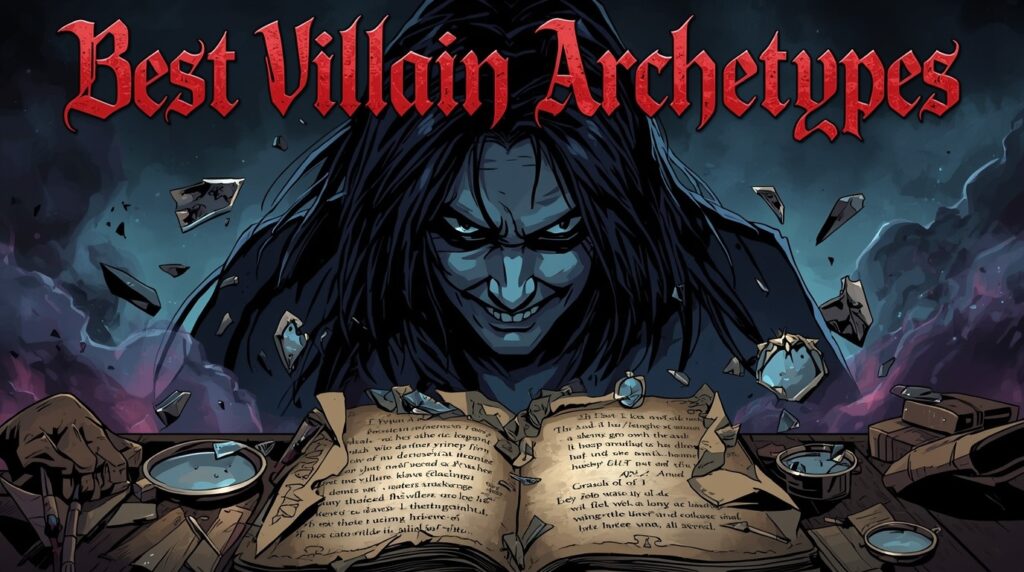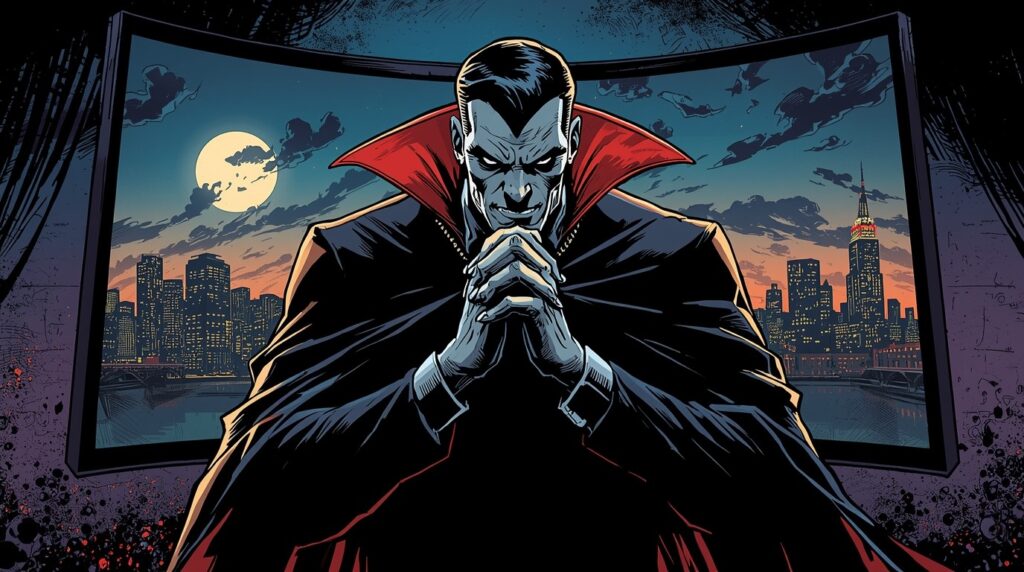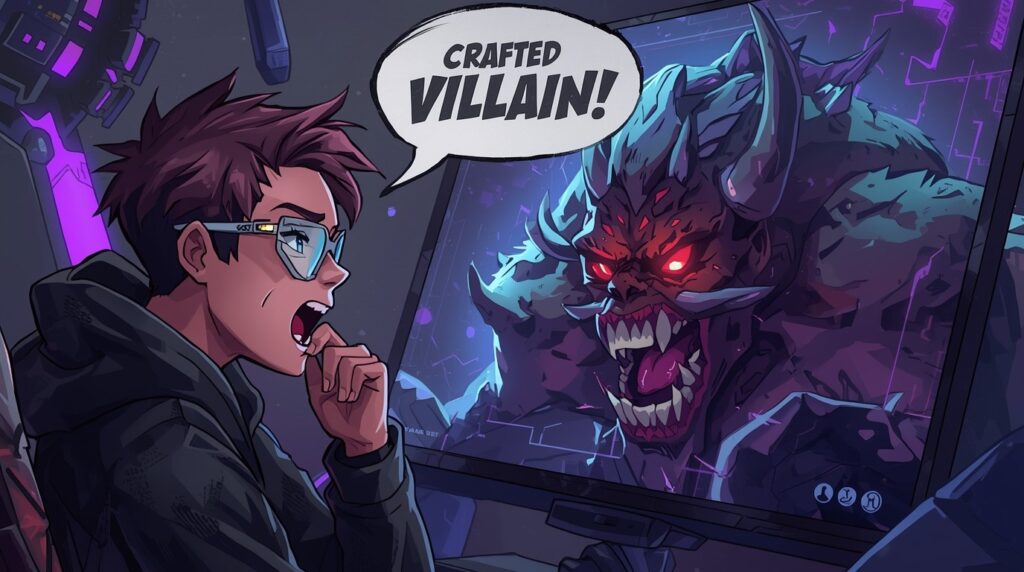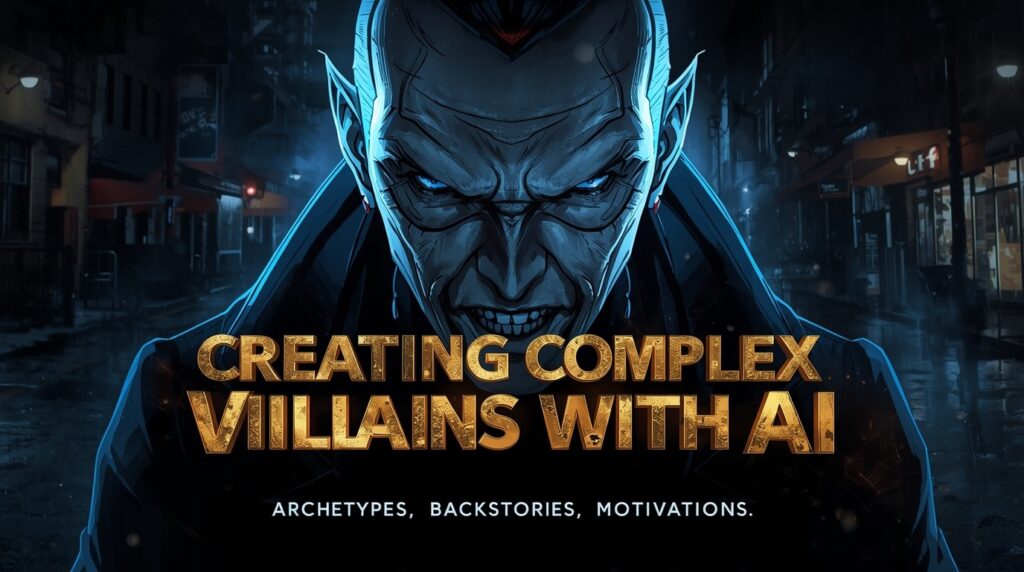Creating Complex Villains with AI: Archetypes, Backstories & Motivations
What if your readers feared your villain more than they loved your hero? That’s the grip you want. Not a mask. Not a trope. A presence that raises the room’s pulse.
👉Here’s the truth: creating a villain should feel simple, real, and fast. It can. You don’t need long speeches or purple prose. You need a wound, a rule, and a plan. Give the foe a reason that hurts. Give them a line they won’t cross. Then make them break everything else.
Picture this. Your party reaches the gate at dusk. The city lights flicker. The guard won’t meet their eyes. Somewhere inside, a calm mind is three moves ahead. One order, and your healer loses safe passage. One lie, and your rogue doubts a friend. You feel it, right? That slow turn of the knife. Stakes rising. Choices shrinking. That’s how a memorable villain sticks.
We’ll build that force together in Summon Worlds. You’ll pick an archetype, forge a backstory, and set clean motives. Then you’ll stage actions that bite. Short steps. Clear choices. Real heat.
Keep reading. In the next section, you’ll get a tight spine you can use tonight, wound, belief, and a first strike that drives the plot. Turn the page, and make your readers hold their breath.
Table of Contents
Why Creating a Villain Is the Key to a Powerful Story
A good villain is the pressure. The test. The mirror. Their choices drive the plot. Their belief rubs against the hero’s belief. That rub sparks change. When the foe is thin, scenes fall flat. When the foe feels true, readers lean forward.
Keep two points in mind. First, a goal is not a motive. A goal is the thing. The gold. The throne. The cure. Villain motivations are the reason the goal matters. The wound under the plan. Second, avoid evil for the sake of it. The sake of being evil is empty. Give roots. Give the cost. Give a rule they will not break. That is how great villains feel human and still hit hard.
👉 Read our article about Character creation
Best Villain Archetypes and How to Create a Memorable Villain

Archetypes help you start fast. They set a frame you can bend. Pick one that fits your world and theme.
- 🧠The Mastermind: Calm. Cold. Two moves ahead. Prefers plans over fists. Uses systems, money, and smart allies. Works when the conflict is about control, trust, and truth.
- 🕺The Corrupted Idealist: Means well in their own mind. It will hurt many to “save” more. This path is thought-provoking because the logic sounds clean until it cuts.
- 🕴️The Tyrant: Order at any price. Breaks unions, guilds, families. Wants the world quiet and neat. Sets rules that the hero must break.
- 🦸The Fallen Hero: Failed once. Swore never again. Pride turns to harm. Their mask is honor. Their wake is ruin.
- 👻The Trickster: Lies with charm. Seeds cause chaos to get what they want. The hero must learn to doubt, test, and verify.
- 👾The Monster: Rage, hunger, or fear set loose. It can be tragic. Works when the theme is survival and the cost of hate.
Use common tropes as a hook, not a crutch. Keep the shape readers know, then flip one key edge. Change the motive. Change the method. Change the loss. Fresh beats follow.
Writing a Villain Backstory: Deep-Seated Wounds and Personal Losses
Backstory is a blade. Keep it sharp. One deep-seated wound. One belief born from that wound. One or two personal losses made the belief stick. Then show how the belief shapes choices on the page. Short. Clear. Costly.
🗺️You can map it like this: wound → belief → behavior. A parent was taken by raiders (wounded). Only power keeps you safe (belief). Gather power and crush dissent (behavior). Now each move has weight. This is the core of creating compelling antagonists: harm with logic, not noise.
In Summon Worlds, open the Character Creator. Add one line for the wound. Ask Character Chat to restate it as a memory. Edit the tone. Save it. You now have a proof scene you can use in play.
👉 Read our article about How to generate character headcanon with AI
Common Mistakes to Avoid When Creating a Villain

- Trap 1️⃣: No motive. You get noise with no core. Fix it by setting one motive that ties to the wound.
- Trap 2️⃣: Goal = motive. They are not the same. State both. Keep them linked.
- Trap 3️⃣: Speech over action. Cut speeches. Add a move that hurts. Then let the hero answer.
- Trap 4️⃣: Lazy “madness.” Do not use illness as a shortcut. It reads dated and unfair. Build logic instead.
- Trap 5️⃣: Overused common tropes with no twist. Dialogue should be tight. Let the foe praise the hero, then twist the praise into a threat. One line that states the creed works well. “Mercy makes graves.” Keep the rest lean and visual. Swap method. Change a cost.
- Trap 6️⃣: No line they won’t cross. Give one rule. It humanizes the villainous character and sets up a sharp break near the end.
👉 Read our article about Character creator – Build your hero with AI
How to Build and Chat With Your Crafted Villain in Summon Worlds

You can plan, write, chat, and art your foe in one place. Here is a fast flow that mixes steps and small checks, not endless lists.
Start with the archetype. Set “Mastermind,” “Tyrant,” or what fits. Add one-line wound. Add the core belief. Ask the AI Character Chat for three motives tied to that belief. Pick the cleanest one. Tell the character to write a short threat. Hear it with Voice. Does it feel too soft? Ask for a harsher version with the same logic.
Next, pick two proof scenes. One painless win for the villain. One cruel choice they justify. Generate a portrait with AI Art. Choose a style that suits your world. Add one prop that echoes motive: a ledger, a mask, a cracked ring. Save the images to a Collection with the lair and the top lieutenants. Share if you like. Keep it private if you want a surprise.
If you play 5e, use 5e tools to frame stats and actions that support the motive. A control-driven foe uses restraint, fear, and laws. A revenge foe strikes supply lines. Let the sheet echo the mind. The plan reads clean at the table.
As you draft, run Character Chat like a war room. Ask the villain to audit their own plan. “What is the weak link?” “If the hero steals X, what do you do next?” The answers give you scene beats you can stage in order. The result is a crafted villain who adapts.
🧭 Ready to Create a Villain Readers Will Never Forget

When the last page turns, readers don’t remember speeches. They remember a choice that cut deep. That’s the mark of a true foe. Creating a villain is about scars, rules, and pressure that reshapes the hero. Start with a clear frame. Twist it to fit your world. Tie motive to loss. Put the proof on the page with bold, visible actions that tip the story forward.
Now make it real. Open Summon Worlds. Build the profile. Set the wound and belief. Chat in-character to test voice. Spin up art to lock tone. Store scenes in a Collection and line up your first strike. You’ll feel the story tighten.
Ready to ship that antagonist? Grab Summon Worlds on your phone. Search for it on Google Play or the App Store. Install. Create. Press start on the villain your readers will fear, and never forget.
Disclaimer: Summon Worlds and the content on summonworlds.com are not affiliated with, endorsed by, or sponsored by Wizards of the Coast LLC. Dungeons & Dragons, D&D, and related terms are registered trademarks of Wizards of the Coast. Any references to D&D game mechanics, settings, or terminology are made for educational, commentary, and fan content purposes only. This blog does not reproduce or distribute official D&D content. All original ideas, characters, and creative content in this post are the intellectual property of OpenForge LLC, the parent company of Summon Worlds.




![{"type":"elementor","siteurl":"https://www.summonworlds.com/wp-json/","elements":[{"id":"f93d843","elType":"widget","isInner":false,"isLocked":false,"settings":{"editor":"Try Summon Worlds for free. ","ha_advanced_tooltip_content":"I am a tooltip","ha_cmc_text":"Happy Addons","align":"center","typography_typography":"custom","typography_font_size":{"unit":"px","size":23,"sizes":[]},"link_color":"#D94FF9","drop_cap":"","text_columns":"","text_columns_tablet":"","text_columns_mobile":"","column_gap":{"unit":"px","size":"","sizes":[]},"column_gap_tablet":{"unit":"px","size":"","sizes":[]},"column_gap_mobile":{"unit":"px","size":"","sizes":[]},"align_tablet":"","align_mobile":"","typography_font_family":"","typography_font_size_tablet":{"unit":"px","size":"","sizes":[]},"typography_font_size_mobile":{"unit":"px","size":"","sizes":[]},"typography_font_weight":"","typography_text_transform":"","typography_font_style":"","typography_text_decoration":"","typography_line_height":{"unit":"px","size":"","sizes":[]},"typography_line_height_tablet":{"unit":"em","size":"","sizes":[]},"typography_line_height_mobile":{"unit":"em","size":"","sizes":[]},"typography_letter_spacing":{"unit":"px","size":"","sizes":[]},"typography_letter_spacing_tablet":{"unit":"px","size":"","sizes":[]},"typography_letter_spacing_mobile":{"unit":"px","size":"","sizes":[]},"typography_word_spacing":{"unit":"px","size":"","sizes":[]},"typography_word_spacing_tablet":{"unit":"em","size":"","sizes":[]},"typography_word_spacing_mobile":{"unit":"em","size":"","sizes":[]},"text_shadow_text_shadow_type":"","text_shadow_text_shadow":{"horizontal":0,"vertical":0,"blur":10,"color":"rgba(0,0,0,0.3)"},"paragraph_spacing":{"unit":"px","size":"","sizes":[]},"paragraph_spacing_tablet":{"unit":"px","size":"","sizes":[]},"paragraph_spacing_mobile":{"unit":"px","size":"","sizes":[]},"text_color":"","link_hover_color":"","link_hover_color_transition_duration":{"unit":"s","size":"","sizes":[]},"drop_cap_view":"default","drop_cap_primary_color":"","drop_cap_secondary_color":"","drop_cap_shadow_text_shadow_type":"","drop_cap_shadow_text_shadow":{"horizontal":0,"vertical":0,"blur":10,"color":"rgba(0,0,0,0.3)"},"drop_cap_size":{"unit":"px","size":5,"sizes":[]},"drop_cap_space":{"unit":"px","size":10,"sizes":[]},"drop_cap_border_radius":{"unit":"%","size":"","sizes":[]},"drop_cap_border_width":{"unit":"px","top":"","right":"","bottom":"","left":"","isLinked":true},"drop_cap_typography_typography":"","drop_cap_typography_font_family":"","drop_cap_typography_font_size":{"unit":"px","size":"","sizes":[]},"drop_cap_typography_font_size_tablet":{"unit":"px","size":"","sizes":[]},"drop_cap_typography_font_size_mobile":{"unit":"px","size":"","sizes":[]},"drop_cap_typography_font_weight":"","drop_cap_typography_text_transform":"","drop_cap_typography_font_style":"","drop_cap_typography_text_decoration":"","drop_cap_typography_line_height":{"unit":"px","size":"","sizes":[]},"drop_cap_typography_line_height_tablet":{"unit":"em","size":"","sizes":[]},"drop_cap_typography_line_height_mobile":{"unit":"em","size":"","sizes":[]},"drop_cap_typography_word_spacing":{"unit":"px","size":"","sizes":[]},"drop_cap_typography_word_spacing_tablet":{"unit":"em","size":"","sizes":[]},"drop_cap_typography_word_spacing_mobile":{"unit":"em","size":"","sizes":[]},"_title":"","_margin":{"unit":"px","top":"","right":"","bottom":"","left":"","isLinked":true},"_margin_tablet":{"unit":"px","top":"","right":"","bottom":"","left":"","isLinked":true},"_margin_mobile":{"unit":"px","top":"","right":"","bottom":"","left":"","isLinked":true},"_padding":{"unit":"px","top":"","right":"","bottom":"","left":"","isLinked":true},"_padding_tablet":{"unit":"px","top":"","right":"","bottom":"","left":"","isLinked":true},"_padding_mobile":{"unit":"px","top":"","right":"","bottom":"","left":"","isLinked":true},"_element_width":"","_element_width_tablet":"","_element_width_mobile":"","_element_custom_width":{"unit":"%","size":"","sizes":[]},"_element_custom_width_tablet":{"unit":"px","size":"","sizes":[]},"_element_custom_width_mobile":{"unit":"px","size":"","sizes":[]},"_grid_column":"","_grid_column_tablet":"","_grid_column_mobile":"","_grid_column_custom":"","_grid_column_custom_tablet":"","_grid_column_custom_mobile":"","_grid_row":"","_grid_row_tablet":"","_grid_row_mobile":"","_grid_row_custom":"","_grid_row_custom_tablet":"","_grid_row_custom_mobile":"","_flex_align_self":"","_flex_align_self_tablet":"","_flex_align_self_mobile":"","_flex_order":"","_flex_order_tablet":"","_flex_order_mobile":"","_flex_order_custom":"","_flex_order_custom_tablet":"","_flex_order_custom_mobile":"","_flex_size":"","_flex_size_tablet":"","_flex_size_mobile":"","_flex_grow":1,"_flex_grow_tablet":"","_flex_grow_mobile":"","_flex_shrink":1,"_flex_shrink_tablet":"","_flex_shrink_mobile":"","_element_vertical_align":"","_element_vertical_align_tablet":"","_element_vertical_align_mobile":"","_position_description":"","_position":"","_offset_orientation_h":"start","_offset_x":{"unit":"px","size":0,"sizes":[]},"_offset_x_tablet":{"unit":"px","size":"","sizes":[]},"_offset_x_mobile":{"unit":"px","size":"","sizes":[]},"_offset_x_end":{"unit":"px","size":0,"sizes":[]},"_offset_x_end_tablet":{"unit":"px","size":"","sizes":[]},"_offset_x_end_mobile":{"unit":"px","size":"","sizes":[]},"_offset_orientation_v":"start","_offset_y":{"unit":"px","size":0,"sizes":[]},"_offset_y_tablet":{"unit":"px","size":"","sizes":[]},"_offset_y_mobile":{"unit":"px","size":"","sizes":[]},"_offset_y_end":{"unit":"px","size":0,"sizes":[]},"_offset_y_end_tablet":{"unit":"px","size":"","sizes":[]},"_offset_y_end_mobile":{"unit":"px","size":"","sizes":[]},"_z_index":"","_z_index_tablet":"","_z_index_mobile":"","_element_id":"","_css_classes":"","e_display_conditions":"","_element_cache":"","wgl_pointer_events":"","ha_floating_fx":"","ha_floating_fx_translate_toggle":"","ha_floating_fx_translate_x":{"unit":"px","size":"","sizes":{"from":0,"to":5}},"ha_floating_fx_translate_y":{"unit":"px","size":"","sizes":{"from":0,"to":5}},"ha_floating_fx_translate_duration":{"unit":"px","size":1000,"sizes":[]},"ha_floating_fx_translate_delay":{"unit":"px","size":"","sizes":[]},"ha_floating_fx_rotate_toggle":"","ha_floating_fx_rotate_x":{"unit":"px","size":"","sizes":{"from":0,"to":45}},"ha_floating_fx_rotate_y":{"unit":"px","size":"","sizes":{"from":0,"to":45}},"ha_floating_fx_rotate_z":{"unit":"px","size":"","sizes":{"from":0,"to":45}},"ha_floating_fx_rotate_duration":{"unit":"px","size":1000,"sizes":[]},"ha_floating_fx_rotate_delay":{"unit":"px","size":"","sizes":[]},"ha_floating_fx_scale_toggle":"","ha_floating_fx_scale_x":{"unit":"px","size":"","sizes":{"from":1,"to":1.2}},"ha_floating_fx_scale_y":{"unit":"px","size":"","sizes":{"from":1,"to":1.2}},"ha_floating_fx_scale_duration":{"unit":"px","size":1000,"sizes":[]},"ha_floating_fx_scale_delay":{"unit":"px","size":"","sizes":[]},"ha_element_link":{"url":"","is_external":"","nofollow":"","custom_attributes":""},"ha_transform_fx":"","ha_transform_fx_translate_toggle":"","ha_transform_fx_translate_x":{"unit":"px","size":"","sizes":[]},"ha_transform_fx_translate_x_tablet":{"unit":"px","size":"","sizes":[]},"ha_transform_fx_translate_x_mobile":{"unit":"px","size":"","sizes":[]},"ha_transform_fx_translate_y":{"unit":"px","size":"","sizes":[]},"ha_transform_fx_translate_y_tablet":{"unit":"px","size":"","sizes":[]},"ha_transform_fx_translate_y_mobile":{"unit":"px","size":"","sizes":[]},"ha_transform_fx_rotate_toggle":"","ha_transform_fx_rotate_mode":"loose","ha_transform_fx_rotate_x":{"unit":"px","size":"","sizes":[]},"ha_transform_fx_rotate_x_tablet":{"unit":"px","size":"","sizes":[]},"ha_transform_fx_rotate_x_mobile":{"unit":"px","size":"","sizes":[]},"ha_transform_fx_rotate_y":{"unit":"px","size":"","sizes":[]},"ha_transform_fx_rotate_y_tablet":{"unit":"px","size":"","sizes":[]},"ha_transform_fx_rotate_y_mobile":{"unit":"px","size":"","sizes":[]},"ha_transform_fx_rotate_z":{"unit":"px","size":"","sizes":[]},"ha_transform_fx_rotate_z_tablet":{"unit":"px","size":"","sizes":[]},"ha_transform_fx_rotate_z_mobile":{"unit":"px","size":"","sizes":[]},"ha_transform_fx_scale_toggle":"","ha_transform_fx_scale_mode":"loose","ha_transform_fx_scale_x":{"unit":"px","size":1,"sizes":[]},"ha_transform_fx_scale_x_tablet":{"unit":"px","size":"","sizes":[]},"ha_transform_fx_scale_x_mobile":{"unit":"px","size":"","sizes":[]},"ha_transform_fx_scale_y":{"unit":"px","size":1,"sizes":[]},"ha_transform_fx_scale_y_tablet":{"unit":"px","size":"","sizes":[]},"ha_transform_fx_scale_y_mobile":{"unit":"px","size":"","sizes":[]},"ha_transform_fx_skew_toggle":"","ha_transform_fx_skew_x":{"unit":"px","size":"","sizes":[]},"ha_transform_fx_skew_x_tablet":{"unit":"px","size":"","sizes":[]},"ha_transform_fx_skew_x_mobile":{"unit":"px","size":"","sizes":[]},"ha_transform_fx_skew_y":{"unit":"px","size":"","sizes":[]},"ha_transform_fx_skew_y_tablet":{"unit":"px","size":"","sizes":[]},"ha_transform_fx_skew_y_mobile":{"unit":"px","size":"","sizes":[]},"ha_transform_fx_translate_toggle_hover":"","ha_transform_fx_translate_x_hover":{"unit":"px","size":"","sizes":[]},"ha_transform_fx_translate_x_hover_tablet":{"unit":"px","size":"","sizes":[]},"ha_transform_fx_translate_x_hover_mobile":{"unit":"px","size":"","sizes":[]},"ha_transform_fx_translate_y_hover":{"unit":"px","size":"","sizes":[]},"ha_transform_fx_translate_y_hover_tablet":{"unit":"px","size":"","sizes":[]},"ha_transform_fx_translate_y_hover_mobile":{"unit":"px","size":"","sizes":[]},"ha_transform_fx_rotate_toggle_hover":"","ha_transform_fx_rotate_mode_hover":"loose","ha_transform_fx_rotate_x_hover":{"unit":"px","size":"","sizes":[]},"ha_transform_fx_rotate_x_hover_tablet":{"unit":"px","size":"","sizes":[]},"ha_transform_fx_rotate_x_hover_mobile":{"unit":"px","size":"","sizes":[]},"ha_transform_fx_rotate_y_hover":{"unit":"px","size":"","sizes":[]},"ha_transform_fx_rotate_y_hover_tablet":{"unit":"px","size":"","sizes":[]},"ha_transform_fx_rotate_y_hover_mobile":{"unit":"px","size":"","sizes":[]},"ha_transform_fx_rotate_z_hover":{"unit":"px","size":"","sizes":[]},"ha_transform_fx_rotate_z_hover_tablet":{"unit":"px","size":"","sizes":[]},"ha_transform_fx_rotate_z_hover_mobile":{"unit":"px","size":"","sizes":[]},"ha_transform_fx_scale_toggle_hover":"","ha_transform_fx_scale_mode_hover":"loose","ha_transform_fx_scale_x_hover":{"unit":"px","size":1,"sizes":[]},"ha_transform_fx_scale_x_hover_tablet":{"unit":"px","size":"","sizes":[]},"ha_transform_fx_scale_x_hover_mobile":{"unit":"px","size":"","sizes":[]},"ha_transform_fx_scale_y_hover":{"unit":"px","size":1,"sizes":[]},"ha_transform_fx_scale_y_hover_tablet":{"unit":"px","size":"","sizes":[]},"ha_transform_fx_scale_y_hover_mobile":{"unit":"px","size":"","sizes":[]},"ha_transform_fx_skew_toggle_hover":"","ha_transform_fx_skew_x_hover":{"unit":"px","size":"","sizes":[]},"ha_transform_fx_skew_x_hover_tablet":{"unit":"px","size":"","sizes":[]},"ha_transform_fx_skew_x_hover_mobile":{"unit":"px","size":"","sizes":[]},"ha_transform_fx_skew_y_hover":{"unit":"px","size":"","sizes":[]},"ha_transform_fx_skew_y_hover_tablet":{"unit":"px","size":"","sizes":[]},"ha_transform_fx_skew_y_hover_mobile":{"unit":"px","size":"","sizes":[]},"ha_transform_fx_transition_duration":{"unit":"px","size":"","sizes":[]},"ha_advanced_tooltip_enable":"","ha_advanced_tooltip_position":"top","ha_advanced_tooltip_position_tablet":"","ha_advanced_tooltip_position_mobile":"","ha_advanced_tooltip_animation":"","ha_advanced_tooltip_duration":1000,"ha_advanced_tooltip_arrow":"true","ha_advanced_tooltip_trigger":"hover","ha_advanced_tooltip_distance":{"unit":"px","size":"0","sizes":[]},"ha_advanced_tooltip_distance_tablet":{"unit":"px","size":"","sizes":[]},"ha_advanced_tooltip_distance_mobile":{"unit":"px","size":"","sizes":[]},"ha_advanced_tooltip_align":"center","ha_advanced_tooltip_align_tablet":"","ha_advanced_tooltip_align_mobile":"","ha_advanced_tooltip_width":{"unit":"px","size":"120","sizes":[]},"ha_advanced_tooltip_width_tablet":{"unit":"px","size":"","sizes":[]},"ha_advanced_tooltip_width_mobile":{"unit":"px","size":"","sizes":[]},"ha_advanced_tooltip_arrow_size":{"unit":"px","size":"5","sizes":[]},"ha_advanced_tooltip_arrow_size_tablet":{"unit":"px","size":"","sizes":[]},"ha_advanced_tooltip_arrow_size_mobile":{"unit":"px","size":"","sizes":[]},"ha_advanced_tooltip_typography_typography":"yes","ha_advanced_tooltip_typography_font_family":"Nunito","ha_advanced_tooltip_typography_font_size":{"unit":"px","size":"14","sizes":[]},"ha_advanced_tooltip_typography_font_size_tablet":{"unit":"px","size":"","sizes":[]},"ha_advanced_tooltip_typography_font_size_mobile":{"unit":"px","size":"","sizes":[]},"ha_advanced_tooltip_typography_font_weight":"500","ha_advanced_tooltip_typography_text_transform":"","ha_advanced_tooltip_typography_font_style":"","ha_advanced_tooltip_typography_text_decoration":"","ha_advanced_tooltip_typography_line_height":{"unit":"px","size":"","sizes":[]},"ha_advanced_tooltip_typography_line_height_tablet":{"unit":"em","size":"","sizes":[]},"ha_advanced_tooltip_typography_line_height_mobile":{"unit":"em","size":"","sizes":[]},"ha_advanced_tooltip_typography_letter_spacing":{"unit":"px","size":"","sizes":[]},"ha_advanced_tooltip_typography_letter_spacing_tablet":{"unit":"px","size":"","sizes":[]},"ha_advanced_tooltip_typography_letter_spacing_mobile":{"unit":"px","size":"","sizes":[]},"ha_advanced_tooltip_typography_word_spacing":{"unit":"px","size":"","sizes":[]},"ha_advanced_tooltip_typography_word_spacing_tablet":{"unit":"em","size":"","sizes":[]},"ha_advanced_tooltip_typography_word_spacing_mobile":{"unit":"em","size":"","sizes":[]},"ha_advanced_tooltip_title_section_bg_color_background":"","ha_advanced_tooltip_title_section_bg_color_gradient_notice":"","ha_advanced_tooltip_title_section_bg_color_color":"","ha_advanced_tooltip_title_section_bg_color_color_stop":{"unit":"%","size":0,"sizes":[]},"ha_advanced_tooltip_title_section_bg_color_color_stop_tablet":{"unit":"%"},"ha_advanced_tooltip_title_section_bg_color_color_stop_mobile":{"unit":"%"},"ha_advanced_tooltip_title_section_bg_color_color_b":"#f2295b","ha_advanced_tooltip_title_section_bg_color_color_b_stop":{"unit":"%","size":100,"sizes":[]},"ha_advanced_tooltip_title_section_bg_color_color_b_stop_tablet":{"unit":"%"},"ha_advanced_tooltip_title_section_bg_color_color_b_stop_mobile":{"unit":"%"},"ha_advanced_tooltip_title_section_bg_color_gradient_type":"linear","ha_advanced_tooltip_title_section_bg_color_gradient_angle":{"unit":"deg","size":180,"sizes":[]},"ha_advanced_tooltip_title_section_bg_color_gradient_angle_tablet":{"unit":"deg"},"ha_advanced_tooltip_title_section_bg_color_gradient_angle_mobile":{"unit":"deg"},"ha_advanced_tooltip_title_section_bg_color_gradient_position":"center center","ha_advanced_tooltip_title_section_bg_color_gradient_position_tablet":"","ha_advanced_tooltip_title_section_bg_color_gradient_position_mobile":"","ha_advanced_tooltip_title_section_bg_color_image":{"url":"","id":"","size":""},"ha_advanced_tooltip_title_section_bg_color_image_tablet":{"url":"","id":"","size":""},"ha_advanced_tooltip_title_section_bg_color_image_mobile":{"url":"","id":"","size":""},"ha_advanced_tooltip_title_section_bg_color_position":"","ha_advanced_tooltip_title_section_bg_color_position_tablet":"","ha_advanced_tooltip_title_section_bg_color_position_mobile":"","ha_advanced_tooltip_title_section_bg_color_xpos":{"unit":"px","size":0,"sizes":[]},"ha_advanced_tooltip_title_section_bg_color_xpos_tablet":{"unit":"px","size":0,"sizes":[]},"ha_advanced_tooltip_title_section_bg_color_xpos_mobile":{"unit":"px","size":0,"sizes":[]},"ha_advanced_tooltip_title_section_bg_color_ypos":{"unit":"px","size":0,"sizes":[]},"ha_advanced_tooltip_title_section_bg_color_ypos_tablet":{"unit":"px","size":0,"sizes":[]},"ha_advanced_tooltip_title_section_bg_color_ypos_mobile":{"unit":"px","size":0,"sizes":[]},"ha_advanced_tooltip_title_section_bg_color_attachment":"","ha_advanced_tooltip_title_section_bg_color_repeat":"","ha_advanced_tooltip_title_section_bg_color_repeat_tablet":"","ha_advanced_tooltip_title_section_bg_color_repeat_mobile":"","ha_advanced_tooltip_title_section_bg_color_size":"","ha_advanced_tooltip_title_section_bg_color_size_tablet":"","ha_advanced_tooltip_title_section_bg_color_size_mobile":"","ha_advanced_tooltip_title_section_bg_color_bg_width":{"unit":"%","size":100,"sizes":[]},"ha_advanced_tooltip_title_section_bg_color_bg_width_tablet":{"unit":"px","size":"","sizes":[]},"ha_advanced_tooltip_title_section_bg_color_bg_width_mobile":{"unit":"px","size":"","sizes":[]},"ha_advanced_tooltip_title_section_bg_color_video_link":"","ha_advanced_tooltip_title_section_bg_color_video_start":"","ha_advanced_tooltip_title_section_bg_color_video_end":"","ha_advanced_tooltip_title_section_bg_color_play_once":"","ha_advanced_tooltip_title_section_bg_color_play_on_mobile":"","ha_advanced_tooltip_title_section_bg_color_privacy_mode":"","ha_advanced_tooltip_title_section_bg_color_video_fallback":{"url":"","id":"","size":""},"ha_advanced_tooltip_title_section_bg_color_slideshow_gallery":[],"ha_advanced_tooltip_title_section_bg_color_slideshow_loop":"yes","ha_advanced_tooltip_title_section_bg_color_slideshow_slide_duration":5000,"ha_advanced_tooltip_title_section_bg_color_slideshow_slide_transition":"fade","ha_advanced_tooltip_title_section_bg_color_slideshow_transition_duration":500,"ha_advanced_tooltip_title_section_bg_color_slideshow_background_size":"","ha_advanced_tooltip_title_section_bg_color_slideshow_background_size_tablet":"","ha_advanced_tooltip_title_section_bg_color_slideshow_background_size_mobile":"","ha_advanced_tooltip_title_section_bg_color_slideshow_background_position":"","ha_advanced_tooltip_title_section_bg_color_slideshow_background_position_tablet":"","ha_advanced_tooltip_title_section_bg_color_slideshow_background_position_mobile":"","ha_advanced_tooltip_title_section_bg_color_slideshow_lazyload":"","ha_advanced_tooltip_title_section_bg_color_slideshow_ken_burns":"","ha_advanced_tooltip_title_section_bg_color_slideshow_ken_burns_zoom_direction":"in","ha_advanced_tooltip_background_color":"#000000","ha_advanced_tooltip_color":"#ffffff","ha_advanced_tooltip_border_border":"","ha_advanced_tooltip_border_width":{"unit":"px","top":"","right":"","bottom":"","left":"","isLinked":true},"ha_advanced_tooltip_border_width_tablet":{"unit":"px","top":"","right":"","bottom":"","left":"","isLinked":true},"ha_advanced_tooltip_border_width_mobile":{"unit":"px","top":"","right":"","bottom":"","left":"","isLinked":true},"ha_advanced_tooltip_border_color":"","ha_advanced_tooltip_border_radius":{"unit":"px","top":"","right":"","bottom":"","left":"","isLinked":true},"ha_advanced_tooltip_border_radius_tablet":{"unit":"px","top":"","right":"","bottom":"","left":"","isLinked":true},"ha_advanced_tooltip_border_radius_mobile":{"unit":"px","top":"","right":"","bottom":"","left":"","isLinked":true},"ha_advanced_tooltip_padding":{"unit":"px","top":"","right":"","bottom":"","left":"","isLinked":true},"ha_advanced_tooltip_padding_tablet":{"unit":"px","top":"","right":"","bottom":"","left":"","isLinked":true},"ha_advanced_tooltip_padding_mobile":{"unit":"px","top":"","right":"","bottom":"","left":"","isLinked":true},"ha_advanced_tooltip_box_shadow_box_shadow_type":"","ha_advanced_tooltip_box_shadow_box_shadow":{"horizontal":0,"vertical":0,"blur":10,"spread":0,"color":"rgba(0,0,0,0.5)"},"ha_advanced_tooltip_box_shadow_box_shadow_position":" ","jkit_transform_rotate":{"unit":"px","size":"","sizes":[]},"jkit_transform_rotate_tablet":{"unit":"px","size":"","sizes":[]},"jkit_transform_rotate_mobile":{"unit":"px","size":"","sizes":[]},"jkit_glass_blur_level":{"unit":"px","size":"","sizes":[]},"jkit_glass_blur_level_tablet":{"unit":"px","size":"","sizes":[]},"jkit_glass_blur_level_mobile":{"unit":"px","size":"","sizes":[]},"ha_cmc_init_notice":"","ha_cmc_switcher":"","ha_cmc_priority_notice":"","ha_default_cmc":"default","ha_cmc_type":"text","ha_cmc_icon":{"value":"fas fa-mouse-pointer","library":"fa-solid"},"ha_cmc_icon_color":"#FFF","ha_cmc_icon_size":22,"ha_cmc_text_color":"#FFF","ha_cmc_text_typo_typography":"","ha_cmc_text_typo_font_family":"","ha_cmc_text_typo_font_size":{"unit":"px","size":"","sizes":[]},"ha_cmc_text_typo_font_size_tablet":{"unit":"px","size":"","sizes":[]},"ha_cmc_text_typo_font_size_mobile":{"unit":"px","size":"","sizes":[]},"ha_cmc_text_typo_font_weight":"","ha_cmc_text_typo_text_transform":"","ha_cmc_text_typo_font_style":"","ha_cmc_text_typo_text_decoration":"","ha_cmc_text_typo_line_height":{"unit":"px","size":"","sizes":[]},"ha_cmc_text_typo_line_height_tablet":{"unit":"em","size":"","sizes":[]},"ha_cmc_text_typo_line_height_mobile":{"unit":"em","size":"","sizes":[]},"ha_cmc_text_typo_letter_spacing":{"unit":"px","size":"","sizes":[]},"ha_cmc_text_typo_letter_spacing_tablet":{"unit":"px","size":"","sizes":[]},"ha_cmc_text_typo_letter_spacing_mobile":{"unit":"px","size":"","sizes":[]},"ha_cmc_text_typo_word_spacing":{"unit":"px","size":"","sizes":[]},"ha_cmc_text_typo_word_spacing_tablet":{"unit":"em","size":"","sizes":[]},"ha_cmc_text_typo_word_spacing_mobile":{"unit":"em","size":"","sizes":[]},"ha_cmc_image":{"url":"","id":"","size":""},"ha_cmc_image_fit":"cover","ha_cmc_img_width":{"unit":"px","size":150,"sizes":[]},"ha_cmc_img_width_tablet":{"unit":"px","size":150,"sizes":[]},"ha_cmc_img_width_mobile":{"unit":"px","size":100,"sizes":[]},"ha_cmc_img_height":{"unit":"px","size":150,"sizes":[]},"ha_cmc_img_height_tablet":{"unit":"px","size":150,"sizes":[]},"ha_cmc_img_height_mobile":{"unit":"px","size":100,"sizes":[]},"ha_cmc_image_border_border":"","ha_cmc_image_border_width":{"unit":"px","top":"","right":"","bottom":"","left":"","isLinked":true},"ha_cmc_image_border_width_tablet":{"unit":"px","top":"","right":"","bottom":"","left":"","isLinked":true},"ha_cmc_image_border_width_mobile":{"unit":"px","top":"","right":"","bottom":"","left":"","isLinked":true},"ha_cmc_image_border_color":"","ha_cmc_img_border_radius":{"unit":"px","top":"0","right":"0","bottom":"0","left":"0","isLinked":true},"ha_cmc_img_border_radius_tablet":{"unit":"px","top":"","right":"","bottom":"","left":"","isLinked":true},"ha_cmc_img_border_radius_mobile":{"unit":"px","top":"","right":"","bottom":"","left":"","isLinked":true},"ha_cmc_img_rotate":"0","ha_cmc_img_rotate_tablet":"","ha_cmc_img_rotate_mobile":"","ha_cmc_img_opacity":"1","ha_enable_img_rotation_switcher":"","ha_cmc_img_rotation_delay":{"unit":"px","size":3,"sizes":[]},"ha_cmc_img_rotation_direction":"clockwise","ha_cmc_img_css_filters_css_filter":"","ha_cmc_img_css_filters_blur":{"unit":"px","size":0,"sizes":[]},"ha_cmc_img_css_filters_brightness":{"unit":"px","size":100,"sizes":[]},"ha_cmc_img_css_filters_contrast":{"unit":"px","size":100,"sizes":[]},"ha_cmc_img_css_filters_saturate":{"unit":"px","size":100,"sizes":[]},"ha_cmc_img_css_filters_hue":{"unit":"px","size":0,"sizes":[]},"ha_cmc_video":{"url":"","id":"","size":""},"ha_cmc_video_fit":"cover","ha_cmc_video_width":{"unit":"px","size":150,"sizes":[]},"ha_cmc_video_width_tablet":{"unit":"px","size":150,"sizes":[]},"ha_cmc_video_width_mobile":{"unit":"px","size":100,"sizes":[]},"ha_cmc_video_height":{"unit":"px","size":150,"sizes":[]},"ha_cmc_video_height_tablet":{"unit":"px","size":150,"sizes":[]},"ha_cmc_video_height_mobile":{"unit":"px","size":100,"sizes":[]},"ha_cmc_video_border_border":"","ha_cmc_video_border_width":{"unit":"px","top":"","right":"","bottom":"","left":"","isLinked":true},"ha_cmc_video_border_width_tablet":{"unit":"px","top":"","right":"","bottom":"","left":"","isLinked":true},"ha_cmc_video_border_width_mobile":{"unit":"px","top":"","right":"","bottom":"","left":"","isLinked":true},"ha_cmc_video_border_color":"","ha_cmc_video_border_radius":{"unit":"%","top":"50","right":"50","bottom":"50","left":"50","isLinked":true},"ha_cmc_video_border_radius_tablet":{"unit":"px","top":"","right":"","bottom":"","left":"","isLinked":true},"ha_cmc_video_border_radius_mobile":{"unit":"px","top":"","right":"","bottom":"","left":"","isLinked":true},"ha_cmc_video_opacity":"1","ha_cmc_cursor_blur_switcher":"","ha_cmc_cursor_blur":{"unit":"px","size":6,"sizes":[]},"ha_cmc_cursor_blur_bg":"#FFFFFF33","ha_cmc_cursor_bg":"#000","ha_cmc_cursor_box_width":{"unit":"px","size":80,"sizes":[]},"ha_cmc_cursor_box_width_tablet":{"unit":"px","size":80,"sizes":[]},"ha_cmc_cursor_box_width_mobile":{"unit":"px","size":80,"sizes":[]},"ha_cmc_cursor_box_height":{"unit":"px","size":80,"sizes":[]},"ha_cmc_cursor_box_height_tablet":{"unit":"px","size":80,"sizes":[]},"ha_cmc_cursor_box_height_mobile":{"unit":"px","size":80,"sizes":[]},"ha_cmc_box_shadow_box_shadow_type":"","ha_cmc_box_shadow_box_shadow":{"horizontal":0,"vertical":0,"blur":10,"spread":0,"color":"rgba(0,0,0,0.5)"},"ha_cmc_box_shadow_box_shadow_position":" ","ha_cmc_cursor_padding":{"unit":"px","top":"0","right":"0","bottom":"0","left":"0","isLinked":true},"ha_cmc_cursor_padding_tablet":{"unit":"px","top":"","right":"","bottom":"","left":"","isLinked":true},"ha_cmc_cursor_padding_mobile":{"unit":"px","top":"","right":"","bottom":"","left":"","isLinked":true},"ha_cmc_cursor_border_border":"","ha_cmc_cursor_border_width":{"unit":"px","top":"","right":"","bottom":"","left":"","isLinked":true},"ha_cmc_cursor_border_width_tablet":{"unit":"px","top":"","right":"","bottom":"","left":"","isLinked":true},"ha_cmc_cursor_border_width_mobile":{"unit":"px","top":"","right":"","bottom":"","left":"","isLinked":true},"ha_cmc_cursor_border_color":"","ha_cmc_cursor_border_radius":{"unit":"px","top":"","right":"","bottom":"","left":"","isLinked":true},"ha_cmc_cursor_border_radius_tablet":{"unit":"px","top":"","right":"","bottom":"","left":"","isLinked":true},"ha_cmc_cursor_border_radius_mobile":{"unit":"px","top":"","right":"","bottom":"","left":"","isLinked":true},"motion_fx_motion_fx_scrolling":"","motion_fx_translateY_effect":"","motion_fx_translateY_direction":"","motion_fx_translateY_speed":{"unit":"px","size":4,"sizes":[]},"motion_fx_translateY_affectedRange":{"unit":"%","size":"","sizes":{"start":0,"end":100}},"motion_fx_translateX_effect":"","motion_fx_translateX_direction":"","motion_fx_translateX_speed":{"unit":"px","size":4,"sizes":[]},"motion_fx_translateX_affectedRange":{"unit":"%","size":"","sizes":{"start":0,"end":100}},"motion_fx_opacity_effect":"","motion_fx_opacity_direction":"out-in","motion_fx_opacity_level":{"unit":"px","size":10,"sizes":[]},"motion_fx_opacity_range":{"unit":"%","size":"","sizes":{"start":20,"end":80}},"motion_fx_blur_effect":"","motion_fx_blur_direction":"out-in","motion_fx_blur_level":{"unit":"px","size":7,"sizes":[]},"motion_fx_blur_range":{"unit":"%","size":"","sizes":{"start":20,"end":80}},"motion_fx_rotateZ_effect":"","motion_fx_rotateZ_direction":"","motion_fx_rotateZ_speed":{"unit":"px","size":1,"sizes":[]},"motion_fx_rotateZ_affectedRange":{"unit":"%","size":"","sizes":{"start":0,"end":100}},"motion_fx_scale_effect":"","motion_fx_scale_direction":"out-in","motion_fx_scale_speed":{"unit":"px","size":4,"sizes":[]},"motion_fx_scale_range":{"unit":"%","size":"","sizes":{"start":20,"end":80}},"motion_fx_transform_origin_x":"center","motion_fx_transform_origin_y":"center","motion_fx_devices":["desktop","tablet","mobile"],"motion_fx_range":"","motion_fx_motion_fx_mouse":"","motion_fx_mouseTrack_effect":"","motion_fx_mouseTrack_direction":"","motion_fx_mouseTrack_speed":{"unit":"px","size":1,"sizes":[]},"motion_fx_tilt_effect":"","motion_fx_tilt_direction":"","motion_fx_tilt_speed":{"unit":"px","size":4,"sizes":[]},"handle_motion_fx_asset_loading":"","sticky":"","sticky_on":["desktop","tablet","mobile"],"sticky_offset":0,"sticky_offset_tablet":"","sticky_offset_mobile":"","sticky_effects_offset":0,"sticky_effects_offset_tablet":"","sticky_effects_offset_mobile":"","sticky_anchor_link_offset":0,"sticky_anchor_link_offset_tablet":"","sticky_anchor_link_offset_mobile":"","sticky_parent":"","_animation":"","_animation_tablet":"","_animation_mobile":"","animation_duration":"","_animation_delay":"","_transform_rotate_popover":"","_transform_rotateZ_effect":{"unit":"px","size":"","sizes":[]},"_transform_rotateZ_effect_tablet":{"unit":"deg","size":"","sizes":[]},"_transform_rotateZ_effect_mobile":{"unit":"deg","size":"","sizes":[]},"_transform_rotate_3d":"","_transform_rotateX_effect":{"unit":"px","size":"","sizes":[]},"_transform_rotateX_effect_tablet":{"unit":"deg","size":"","sizes":[]},"_transform_rotateX_effect_mobile":{"unit":"deg","size":"","sizes":[]},"_transform_rotateY_effect":{"unit":"px","size":"","sizes":[]},"_transform_rotateY_effect_tablet":{"unit":"deg","size":"","sizes":[]},"_transform_rotateY_effect_mobile":{"unit":"deg","size":"","sizes":[]},"_transform_perspective_effect":{"unit":"px","size":"","sizes":[]},"_transform_perspective_effect_tablet":{"unit":"px","size":"","sizes":[]},"_transform_perspective_effect_mobile":{"unit":"px","size":"","sizes":[]},"_transform_translate_popover":"","_transform_translateX_effect":{"unit":"px","size":"","sizes":[]},"_transform_translateX_effect_tablet":{"unit":"px","size":"","sizes":[]},"_transform_translateX_effect_mobile":{"unit":"px","size":"","sizes":[]},"_transform_translateY_effect":{"unit":"px","size":"","sizes":[]},"_transform_translateY_effect_tablet":{"unit":"px","size":"","sizes":[]},"_transform_translateY_effect_mobile":{"unit":"px","size":"","sizes":[]},"_transform_scale_popover":"","_transform_keep_proportions":"yes","_transform_scale_effect":{"unit":"px","size":"","sizes":[]},"_transform_scale_effect_tablet":{"unit":"px","size":"","sizes":[]},"_transform_scale_effect_mobile":{"unit":"px","size":"","sizes":[]},"_transform_scaleX_effect":{"unit":"px","size":"","sizes":[]},"_transform_scaleX_effect_tablet":{"unit":"px","size":"","sizes":[]},"_transform_scaleX_effect_mobile":{"unit":"px","size":"","sizes":[]},"_transform_scaleY_effect":{"unit":"px","size":"","sizes":[]},"_transform_scaleY_effect_tablet":{"unit":"px","size":"","sizes":[]},"_transform_scaleY_effect_mobile":{"unit":"px","size":"","sizes":[]},"_transform_skew_popover":"","_transform_skewX_effect":{"unit":"px","size":"","sizes":[]},"_transform_skewX_effect_tablet":{"unit":"deg","size":"","sizes":[]},"_transform_skewX_effect_mobile":{"unit":"deg","size":"","sizes":[]},"_transform_skewY_effect":{"unit":"px","size":"","sizes":[]},"_transform_skewY_effect_tablet":{"unit":"deg","size":"","sizes":[]},"_transform_skewY_effect_mobile":{"unit":"deg","size":"","sizes":[]},"_transform_flipX_effect":"","_transform_flipY_effect":"","_transform_rotate_popover_hover":"","_transform_rotateZ_effect_hover":{"unit":"px","size":"","sizes":[]},"_transform_rotateZ_effect_hover_tablet":{"unit":"deg","size":"","sizes":[]},"_transform_rotateZ_effect_hover_mobile":{"unit":"deg","size":"","sizes":[]},"_transform_rotate_3d_hover":"","_transform_rotateX_effect_hover":{"unit":"px","size":"","sizes":[]},"_transform_rotateX_effect_hover_tablet":{"unit":"deg","size":"","sizes":[]},"_transform_rotateX_effect_hover_mobile":{"unit":"deg","size":"","sizes":[]},"_transform_rotateY_effect_hover":{"unit":"px","size":"","sizes":[]},"_transform_rotateY_effect_hover_tablet":{"unit":"deg","size":"","sizes":[]},"_transform_rotateY_effect_hover_mobile":{"unit":"deg","size":"","sizes":[]},"_transform_perspective_effect_hover":{"unit":"px","size":"","sizes":[]},"_transform_perspective_effect_hover_tablet":{"unit":"px","size":"","sizes":[]},"_transform_perspective_effect_hover_mobile":{"unit":"px","size":"","sizes":[]},"_transform_translate_popover_hover":"","_transform_translateX_effect_hover":{"unit":"px","size":"","sizes":[]},"_transform_translateX_effect_hover_tablet":{"unit":"px","size":"","sizes":[]},"_transform_translateX_effect_hover_mobile":{"unit":"px","size":"","sizes":[]},"_transform_translateY_effect_hover":{"unit":"px","size":"","sizes":[]},"_transform_translateY_effect_hover_tablet":{"unit":"px","size":"","sizes":[]},"_transform_translateY_effect_hover_mobile":{"unit":"px","size":"","sizes":[]},"_transform_scale_popover_hover":"","_transform_keep_proportions_hover":"yes","_transform_scale_effect_hover":{"unit":"px","size":"","sizes":[]},"_transform_scale_effect_hover_tablet":{"unit":"px","size":"","sizes":[]},"_transform_scale_effect_hover_mobile":{"unit":"px","size":"","sizes":[]},"_transform_scaleX_effect_hover":{"unit":"px","size":"","sizes":[]},"_transform_scaleX_effect_hover_tablet":{"unit":"px","size":"","sizes":[]},"_transform_scaleX_effect_hover_mobile":{"unit":"px","size":"","sizes":[]},"_transform_scaleY_effect_hover":{"unit":"px","size":"","sizes":[]},"_transform_scaleY_effect_hover_tablet":{"unit":"px","size":"","sizes":[]},"_transform_scaleY_effect_hover_mobile":{"unit":"px","size":"","sizes":[]},"_transform_skew_popover_hover":"","_transform_skewX_effect_hover":{"unit":"px","size":"","sizes":[]},"_transform_skewX_effect_hover_tablet":{"unit":"deg","size":"","sizes":[]},"_transform_skewX_effect_hover_mobile":{"unit":"deg","size":"","sizes":[]},"_transform_skewY_effect_hover":{"unit":"px","size":"","sizes":[]},"_transform_skewY_effect_hover_tablet":{"unit":"deg","size":"","sizes":[]},"_transform_skewY_effect_hover_mobile":{"unit":"deg","size":"","sizes":[]},"_transform_flipX_effect_hover":"","_transform_flipY_effect_hover":"","_transform_transition_hover":{"unit":"px","size":"","sizes":[]},"motion_fx_transform_x_anchor_point":"","motion_fx_transform_x_anchor_point_tablet":"","motion_fx_transform_x_anchor_point_mobile":"","motion_fx_transform_y_anchor_point":"","motion_fx_transform_y_anchor_point_tablet":"","motion_fx_transform_y_anchor_point_mobile":"","_background_background":"","_background_gradient_notice":"","_background_color":"","_background_color_stop":{"unit":"%","size":0,"sizes":[]},"_background_color_stop_tablet":{"unit":"%"},"_background_color_stop_mobile":{"unit":"%"},"_background_color_b":"#f2295b","_background_color_b_stop":{"unit":"%","size":100,"sizes":[]},"_background_color_b_stop_tablet":{"unit":"%"},"_background_color_b_stop_mobile":{"unit":"%"},"_background_gradient_type":"linear","_background_gradient_angle":{"unit":"deg","size":180,"sizes":[]},"_background_gradient_angle_tablet":{"unit":"deg"},"_background_gradient_angle_mobile":{"unit":"deg"},"_background_gradient_position":"center center","_background_gradient_position_tablet":"","_background_gradient_position_mobile":"","_background_image":{"url":"","id":"","size":""},"_background_image_tablet":{"url":"","id":"","size":""},"_background_image_mobile":{"url":"","id":"","size":""},"_background_position":"","_background_position_tablet":"","_background_position_mobile":"","_background_xpos":{"unit":"px","size":0,"sizes":[]},"_background_xpos_tablet":{"unit":"px","size":0,"sizes":[]},"_background_xpos_mobile":{"unit":"px","size":0,"sizes":[]},"_background_ypos":{"unit":"px","size":0,"sizes":[]},"_background_ypos_tablet":{"unit":"px","size":0,"sizes":[]},"_background_ypos_mobile":{"unit":"px","size":0,"sizes":[]},"_background_attachment":"","_background_repeat":"","_background_repeat_tablet":"","_background_repeat_mobile":"","_background_size":"","_background_size_tablet":"","_background_size_mobile":"","_background_bg_width":{"unit":"%","size":100,"sizes":[]},"_background_bg_width_tablet":{"unit":"px","size":"","sizes":[]},"_background_bg_width_mobile":{"unit":"px","size":"","sizes":[]},"_background_video_link":"","_background_video_start":"","_background_video_end":"","_background_play_once":"","_background_play_on_mobile":"","_background_privacy_mode":"","_background_video_fallback":{"url":"","id":"","size":""},"_background_slideshow_gallery":[],"_background_slideshow_loop":"yes","_background_slideshow_slide_duration":5000,"_background_slideshow_slide_transition":"fade","_background_slideshow_transition_duration":500,"_background_slideshow_background_size":"","_background_slideshow_background_size_tablet":"","_background_slideshow_background_size_mobile":"","_background_slideshow_background_position":"","_background_slideshow_background_position_tablet":"","_background_slideshow_background_position_mobile":"","_background_slideshow_lazyload":"","_background_slideshow_ken_burns":"","_background_slideshow_ken_burns_zoom_direction":"in","_background_hover_background":"","_background_hover_gradient_notice":"","_background_hover_color":"","_background_hover_color_stop":{"unit":"%","size":0,"sizes":[]},"_background_hover_color_stop_tablet":{"unit":"%"},"_background_hover_color_stop_mobile":{"unit":"%"},"_background_hover_color_b":"#f2295b","_background_hover_color_b_stop":{"unit":"%","size":100,"sizes":[]},"_background_hover_color_b_stop_tablet":{"unit":"%"},"_background_hover_color_b_stop_mobile":{"unit":"%"},"_background_hover_gradient_type":"linear","_background_hover_gradient_angle":{"unit":"deg","size":180,"sizes":[]},"_background_hover_gradient_angle_tablet":{"unit":"deg"},"_background_hover_gradient_angle_mobile":{"unit":"deg"},"_background_hover_gradient_position":"center center","_background_hover_gradient_position_tablet":"","_background_hover_gradient_position_mobile":"","_background_hover_image":{"url":"","id":"","size":""},"_background_hover_image_tablet":{"url":"","id":"","size":""},"_background_hover_image_mobile":{"url":"","id":"","size":""},"_background_hover_position":"","_background_hover_position_tablet":"","_background_hover_position_mobile":"","_background_hover_xpos":{"unit":"px","size":0,"sizes":[]},"_background_hover_xpos_tablet":{"unit":"px","size":0,"sizes":[]},"_background_hover_xpos_mobile":{"unit":"px","size":0,"sizes":[]},"_background_hover_ypos":{"unit":"px","size":0,"sizes":[]},"_background_hover_ypos_tablet":{"unit":"px","size":0,"sizes":[]},"_background_hover_ypos_mobile":{"unit":"px","size":0,"sizes":[]},"_background_hover_attachment":"","_background_hover_repeat":"","_background_hover_repeat_tablet":"","_background_hover_repeat_mobile":"","_background_hover_size":"","_background_hover_size_tablet":"","_background_hover_size_mobile":"","_background_hover_bg_width":{"unit":"%","size":100,"sizes":[]},"_background_hover_bg_width_tablet":{"unit":"px","size":"","sizes":[]},"_background_hover_bg_width_mobile":{"unit":"px","size":"","sizes":[]},"_background_hover_video_link":"","_background_hover_video_start":"","_background_hover_video_end":"","_background_hover_play_once":"","_background_hover_play_on_mobile":"","_background_hover_privacy_mode":"","_background_hover_video_fallback":{"url":"","id":"","size":""},"_background_hover_slideshow_gallery":[],"_background_hover_slideshow_loop":"yes","_background_hover_slideshow_slide_duration":5000,"_background_hover_slideshow_slide_transition":"fade","_background_hover_slideshow_transition_duration":500,"_background_hover_slideshow_background_size":"","_background_hover_slideshow_background_size_tablet":"","_background_hover_slideshow_background_size_mobile":"","_background_hover_slideshow_background_position":"","_background_hover_slideshow_background_position_tablet":"","_background_hover_slideshow_background_position_mobile":"","_background_hover_slideshow_lazyload":"","_background_hover_slideshow_ken_burns":"","_background_hover_slideshow_ken_burns_zoom_direction":"in","_background_hover_transition":{"unit":"px","size":"","sizes":[]},"_ha_background_overlay_cls_added":"overlay","_ha_background_overlay_background":"","_ha_background_overlay_gradient_notice":"","_ha_background_overlay_color":"","_ha_background_overlay_color_stop":{"unit":"%","size":0,"sizes":[]},"_ha_background_overlay_color_stop_tablet":{"unit":"%"},"_ha_background_overlay_color_stop_mobile":{"unit":"%"},"_ha_background_overlay_color_b":"#f2295b","_ha_background_overlay_color_b_stop":{"unit":"%","size":100,"sizes":[]},"_ha_background_overlay_color_b_stop_tablet":{"unit":"%"},"_ha_background_overlay_color_b_stop_mobile":{"unit":"%"},"_ha_background_overlay_gradient_type":"linear","_ha_background_overlay_gradient_angle":{"unit":"deg","size":180,"sizes":[]},"_ha_background_overlay_gradient_angle_tablet":{"unit":"deg"},"_ha_background_overlay_gradient_angle_mobile":{"unit":"deg"},"_ha_background_overlay_gradient_position":"center center","_ha_background_overlay_gradient_position_tablet":"","_ha_background_overlay_gradient_position_mobile":"","_ha_background_overlay_image":{"url":"","id":"","size":""},"_ha_background_overlay_image_tablet":{"url":"","id":"","size":""},"_ha_background_overlay_image_mobile":{"url":"","id":"","size":""},"_ha_background_overlay_position":"","_ha_background_overlay_position_tablet":"","_ha_background_overlay_position_mobile":"","_ha_background_overlay_xpos":{"unit":"px","size":0,"sizes":[]},"_ha_background_overlay_xpos_tablet":{"unit":"px","size":0,"sizes":[]},"_ha_background_overlay_xpos_mobile":{"unit":"px","size":0,"sizes":[]},"_ha_background_overlay_ypos":{"unit":"px","size":0,"sizes":[]},"_ha_background_overlay_ypos_tablet":{"unit":"px","size":0,"sizes":[]},"_ha_background_overlay_ypos_mobile":{"unit":"px","size":0,"sizes":[]},"_ha_background_overlay_attachment":"","_ha_background_overlay_repeat":"","_ha_background_overlay_repeat_tablet":"","_ha_background_overlay_repeat_mobile":"","_ha_background_overlay_size":"","_ha_background_overlay_size_tablet":"","_ha_background_overlay_size_mobile":"","_ha_background_overlay_bg_width":{"unit":"%","size":100,"sizes":[]},"_ha_background_overlay_bg_width_tablet":{"unit":"px","size":"","sizes":[]},"_ha_background_overlay_bg_width_mobile":{"unit":"px","size":"","sizes":[]},"_ha_background_overlay_video_link":"","_ha_background_overlay_video_start":"","_ha_background_overlay_video_end":"","_ha_background_overlay_play_once":"","_ha_background_overlay_play_on_mobile":"","_ha_background_overlay_privacy_mode":"","_ha_background_overlay_video_fallback":{"url":"","id":"","size":""},"_ha_background_overlay_slideshow_gallery":[],"_ha_background_overlay_slideshow_loop":"yes","_ha_background_overlay_slideshow_slide_duration":5000,"_ha_background_overlay_slideshow_slide_transition":"fade","_ha_background_overlay_slideshow_transition_duration":500,"_ha_background_overlay_slideshow_background_size":"","_ha_background_overlay_slideshow_background_size_tablet":"","_ha_background_overlay_slideshow_background_size_mobile":"","_ha_background_overlay_slideshow_background_position":"","_ha_background_overlay_slideshow_background_position_tablet":"","_ha_background_overlay_slideshow_background_position_mobile":"","_ha_background_overlay_slideshow_lazyload":"","_ha_background_overlay_slideshow_ken_burns":"","_ha_background_overlay_slideshow_ken_burns_zoom_direction":"in","_ha_background_overlay_opacity":{"unit":"px","size":0.5,"sizes":[]},"_ha_css_filters_css_filter":"","_ha_css_filters_blur":{"unit":"px","size":0,"sizes":[]},"_ha_css_filters_brightness":{"unit":"px","size":100,"sizes":[]},"_ha_css_filters_contrast":{"unit":"px","size":100,"sizes":[]},"_ha_css_filters_saturate":{"unit":"px","size":100,"sizes":[]},"_ha_css_filters_hue":{"unit":"px","size":0,"sizes":[]},"_ha_overlay_blend_mode":"","_ha_background_overlay_hover_background":"","_ha_background_overlay_hover_gradient_notice":"","_ha_background_overlay_hover_color":"","_ha_background_overlay_hover_color_stop":{"unit":"%","size":0,"sizes":[]},"_ha_background_overlay_hover_color_stop_tablet":{"unit":"%"},"_ha_background_overlay_hover_color_stop_mobile":{"unit":"%"},"_ha_background_overlay_hover_color_b":"#f2295b","_ha_background_overlay_hover_color_b_stop":{"unit":"%","size":100,"sizes":[]},"_ha_background_overlay_hover_color_b_stop_tablet":{"unit":"%"},"_ha_background_overlay_hover_color_b_stop_mobile":{"unit":"%"},"_ha_background_overlay_hover_gradient_type":"linear","_ha_background_overlay_hover_gradient_angle":{"unit":"deg","size":180,"sizes":[]},"_ha_background_overlay_hover_gradient_angle_tablet":{"unit":"deg"},"_ha_background_overlay_hover_gradient_angle_mobile":{"unit":"deg"},"_ha_background_overlay_hover_gradient_position":"center center","_ha_background_overlay_hover_gradient_position_tablet":"","_ha_background_overlay_hover_gradient_position_mobile":"","_ha_background_overlay_hover_image":{"url":"","id":"","size":""},"_ha_background_overlay_hover_image_tablet":{"url":"","id":"","size":""},"_ha_background_overlay_hover_image_mobile":{"url":"","id":"","size":""},"_ha_background_overlay_hover_position":"","_ha_background_overlay_hover_position_tablet":"","_ha_background_overlay_hover_position_mobile":"","_ha_background_overlay_hover_xpos":{"unit":"px","size":0,"sizes":[]},"_ha_background_overlay_hover_xpos_tablet":{"unit":"px","size":0,"sizes":[]},"_ha_background_overlay_hover_xpos_mobile":{"unit":"px","size":0,"sizes":[]},"_ha_background_overlay_hover_ypos":{"unit":"px","size":0,"sizes":[]},"_ha_background_overlay_hover_ypos_tablet":{"unit":"px","size":0,"sizes":[]},"_ha_background_overlay_hover_ypos_mobile":{"unit":"px","size":0,"sizes":[]},"_ha_background_overlay_hover_attachment":"","_ha_background_overlay_hover_repeat":"","_ha_background_overlay_hover_repeat_tablet":"","_ha_background_overlay_hover_repeat_mobile":"","_ha_background_overlay_hover_size":"","_ha_background_overlay_hover_size_tablet":"","_ha_background_overlay_hover_size_mobile":"","_ha_background_overlay_hover_bg_width":{"unit":"%","size":100,"sizes":[]},"_ha_background_overlay_hover_bg_width_tablet":{"unit":"px","size":"","sizes":[]},"_ha_background_overlay_hover_bg_width_mobile":{"unit":"px","size":"","sizes":[]},"_ha_background_overlay_hover_video_link":"","_ha_background_overlay_hover_video_start":"","_ha_background_overlay_hover_video_end":"","_ha_background_overlay_hover_play_once":"","_ha_background_overlay_hover_play_on_mobile":"","_ha_background_overlay_hover_privacy_mode":"","_ha_background_overlay_hover_video_fallback":{"url":"","id":"","size":""},"_ha_background_overlay_hover_slideshow_gallery":[],"_ha_background_overlay_hover_slideshow_loop":"yes","_ha_background_overlay_hover_slideshow_slide_duration":5000,"_ha_background_overlay_hover_slideshow_slide_transition":"fade","_ha_background_overlay_hover_slideshow_transition_duration":500,"_ha_background_overlay_hover_slideshow_background_size":"","_ha_background_overlay_hover_slideshow_background_size_tablet":"","_ha_background_overlay_hover_slideshow_background_size_mobile":"","_ha_background_overlay_hover_slideshow_background_position":"","_ha_background_overlay_hover_slideshow_background_position_tablet":"","_ha_background_overlay_hover_slideshow_background_position_mobile":"","_ha_background_overlay_hover_slideshow_lazyload":"","_ha_background_overlay_hover_slideshow_ken_burns":"","_ha_background_overlay_hover_slideshow_ken_burns_zoom_direction":"in","_ha_background_overlay_hover_opacity":{"unit":"px","size":0.5,"sizes":[]},"_ha_css_filters_hover_css_filter":"","_ha_css_filters_hover_blur":{"unit":"px","size":0,"sizes":[]},"_ha_css_filters_hover_brightness":{"unit":"px","size":100,"sizes":[]},"_ha_css_filters_hover_contrast":{"unit":"px","size":100,"sizes":[]},"_ha_css_filters_hover_saturate":{"unit":"px","size":100,"sizes":[]},"_ha_css_filters_hover_hue":{"unit":"px","size":0,"sizes":[]},"_ha_background_overlay_hover_transition":{"unit":"px","size":0.3,"sizes":[]},"_border_border":"","_border_width":{"unit":"px","top":"","right":"","bottom":"","left":"","isLinked":true},"_border_width_tablet":{"unit":"px","top":"","right":"","bottom":"","left":"","isLinked":true},"_border_width_mobile":{"unit":"px","top":"","right":"","bottom":"","left":"","isLinked":true},"_border_color":"","_border_radius":{"unit":"px","top":"","right":"","bottom":"","left":"","isLinked":true},"_border_radius_tablet":{"unit":"px","top":"","right":"","bottom":"","left":"","isLinked":true},"_border_radius_mobile":{"unit":"px","top":"","right":"","bottom":"","left":"","isLinked":true},"_box_shadow_box_shadow_type":"","_box_shadow_box_shadow":{"horizontal":0,"vertical":0,"blur":10,"spread":0,"color":"rgba(0,0,0,0.5)"},"_box_shadow_box_shadow_position":" ","_border_hover_border":"","_border_hover_width":{"unit":"px","top":"","right":"","bottom":"","left":"","isLinked":true},"_border_hover_width_tablet":{"unit":"px","top":"","right":"","bottom":"","left":"","isLinked":true},"_border_hover_width_mobile":{"unit":"px","top":"","right":"","bottom":"","left":"","isLinked":true},"_border_hover_color":"","_border_radius_hover":{"unit":"px","top":"","right":"","bottom":"","left":"","isLinked":true},"_border_radius_hover_tablet":{"unit":"px","top":"","right":"","bottom":"","left":"","isLinked":true},"_border_radius_hover_mobile":{"unit":"px","top":"","right":"","bottom":"","left":"","isLinked":true},"_box_shadow_hover_box_shadow_type":"","_box_shadow_hover_box_shadow":{"horizontal":0,"vertical":0,"blur":10,"spread":0,"color":"rgba(0,0,0,0.5)"},"_box_shadow_hover_box_shadow_position":" ","_border_hover_transition":{"unit":"px","size":"","sizes":[]},"_mask_switch":"","_mask_shape":"circle","_mask_image":{"url":"","id":"","size":""},"_mask_image_tablet":{"url":"","id":"","size":""},"_mask_image_mobile":{"url":"","id":"","size":""},"_mask_size":"contain","_mask_size_tablet":"","_mask_size_mobile":"","_mask_size_scale":{"unit":"%","size":100,"sizes":[]},"_mask_size_scale_tablet":{"unit":"px","size":"","sizes":[]},"_mask_size_scale_mobile":{"unit":"px","size":"","sizes":[]},"_mask_position":"center center","_mask_position_tablet":"","_mask_position_mobile":"","_mask_position_x":{"unit":"%","size":0,"sizes":[]},"_mask_position_x_tablet":{"unit":"px","size":"","sizes":[]},"_mask_position_x_mobile":{"unit":"px","size":"","sizes":[]},"_mask_position_y":{"unit":"%","size":0,"sizes":[]},"_mask_position_y_tablet":{"unit":"px","size":"","sizes":[]},"_mask_position_y_mobile":{"unit":"px","size":"","sizes":[]},"_mask_repeat":"no-repeat","_mask_repeat_tablet":"","_mask_repeat_mobile":"","hide_desktop":"","hide_tablet":"","hide_mobile":"","wgl_hide_el_under_enable":"","wgl_hide_el_under":{"unit":"px","size":0,"sizes":[]},"_attributes":"","custom_css":""},"defaultEditSettings":{"defaultEditRoute":"content"},"elements":[],"widgetType":"text-editor","htmlCache":"\t\t\n\t\t\t\t\t\t\t\t\t\t\n\t\t\t\tTry Summon Worlds for free. \t\t\t\t\t\n\t\t\t\t\t\t\t\t\n\t\t","editSettings":{"defaultEditRoute":"content"}}]}](https://www.summonworlds.com/wp-content/uploads/2025/11/h-1.jpg)
